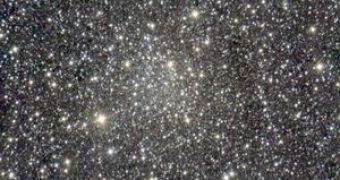German astronomers have discovered a rich globular cluster of about 100,000 stars in the center of our Galaxy, placed 30,000 light-years away from the solar system and 10,000 light-years away from the Galactic Centre.
Globular star clusters are groups of stars with similar ages, composition and distances representing 10 billion years old fossils in our galaxy, almost as old as the Universe itself and harboring useful information. "The properties of globular clusters are deeply connected with the history of their host galaxy. We believe today that galaxy collisions, galaxy cannibalism, as well as galaxy mergers leave their imprint in the globular cluster population of any given galaxy. Thus, when investigating globular clusters we hope to be able to use them as an acid test for our understanding of the formation and evolution of galaxies," said lead-author Dirk Froebrich from the University of Kent.
Roughly 150 globular clusters are known in the Milky Way, each composed of hundreds of thousands of stars.
Until the mid 1990s, globular clusters were detected by visual inspection of photographic plates, which can miss many clusters, especially those that are close to the disc of the Galaxy, hidden by dense dust and gas, problem surpassed by the employment of modern, sensitive infrared detectors, able to pierce trough the thick "galactic fog".
New globular clusters can offer information about the distribution of mass in the Galaxy by investigating their orbits. "It has been estimated that the region close to the Galactic Centre might contain about 10 so far unknown globular clusters and we have started a large campaign to unveil and characterize them," explained co-researcher Helmut Meusinger, from the Th?ringer Landessternwarte Tautenburg.
The systematic and automated large-scale (14,400 square degrees) search for globular cluster candidates in the entire Galactic Plane, based on the near-infrared Two Micron All Sky Survey (2 MASS) left just about a dozen candidate objects.
Based on three different near-infrared filter images, ten times deeper and which have a much better angular resolution than the original 2MASS images, the astronomers spotted one candidate, called FSR 1735. "The unique images we have obtained reveal that the nebulous appearance of the cluster in previous images is in fact due to a large number of faint stars. The images show a beautiful, rich, and circular accumulation of stars", said Froebrich.
"All the evidence supports the interpretation that FSR 1735 is a new globular cluster in the inner Milky Way. However, to be sure, we now need to measure the age of the cluster accurately, and this requires still deeper observations", said co-researcher Aleks Scholz, from the University of St Andrews, UK.
The cluster is roughly 7 light-years wide (half the distance between the Sun and its nearest star, Proxima Centauri) and its 100,000 stars have a total estimated mass 65,000 times the Sun's mass and 5-8 times less heavy elements than our star. "On its way to our Solar System, the light coming from the stars in the FSR 1735 cluster has to penetrate a thick cloud of dust and gas. This is one of the reasons why this cluster was hard to find in previous surveys", said Meusinger.

 14 DAY TRIAL //
14 DAY TRIAL //